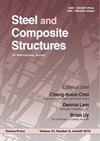l型钢混凝土柱-梁平面及空间节点的抗震性能与强度
IF 3.9
3区 工程技术
Q1 CONSTRUCTION & BUILDING TECHNOLOGY
引用次数: 4
摘要
本文对钢筋混凝土(SRC) l形柱-钢筋混凝土(RC)梁节点的抗震性能进行了试验和数值研究。通过4个平面节点和7个空间节点,对型钢形态、轴压比、加载角度、楼板存在等参数进行了研究。分析了其承载能力、延性、层间漂移比、耗能能力和刚度退化等荷载-位移响应特性。结果表明:平面节点和空间节点梁端分别出现剪切破坏和弯曲破坏;楼板钢筋混凝土节点在楼板和梁底部出现塑性铰破坏。结果表明:实心腹板钢空间节点的滞回曲线比空心腹板钢空间节点的滞回曲线更丰满;平面节点的承载力高于空间节点,而消能能力和延性则相反。高压缩比有助于提高接头的承载力和初始刚度。l型柱框架节点的弹塑性层间变形能力满足规范要求。提出了基于叠加理论和平衡塑性桁架模型的节理抗剪设计公式,可供工程应用。本文章由计算机程序翻译,如有差异,请以英文原文为准。
Seismic behavior and strength of L-shaped steel reinforced concrete column-concrete beam planar and spatial joints
The study presented experimental and numerical investigation on the seismic performance of steel reinforced concrete (SRC) L-shaped column- reinforced concrete (RC) beam joints. Various parameters described as steel configuration form, axial compressive ratio, loading angle, and the existence of slab were examined through 4 planar joints and 7 spatial joints. The characteristics of the load-displacement response included the bearing capacity, ductility, story drift ratio, energy-dissipating capacity, and stiffness degradation were analyzed. The results showed that shear failure and flexural failure in the beam tip were observed for planar joints and spatial joint, respectively. And RC joint with slab failed with the plastic hinge in the slab and bottom of the beam. The results indicated that hysteretic curves of spatial joints with solid-web steel were plumper than those with hollow-web specimens. The capacity of planar joints was higher than that of space joints, while the opposite was true for energy-dissipation capacity and ductility. The high compression ratio contributed to the increase in capacity and initial stiffness of the joint. The elastic and elastic-plastic story deformation capacity of L-shaped column frame joints satisfied the code requirement. A design formula of joint shear resistance based on the superposition theory and equilibrium plasticity truss model was proposed for engineering application.
求助全文
通过发布文献求助,成功后即可免费获取论文全文。
去求助
来源期刊

Steel and Composite Structures
工程技术-材料科学:复合
CiteScore
8.50
自引率
19.60%
发文量
0
审稿时长
7.5 months
期刊介绍:
Steel & Composite Structures, An International Journal, provides and excellent publication channel which reports the up-to-date research developments in the steel structures and steel-concrete composite structures, and FRP plated structures from the international steel community. The research results reported in this journal address all the aspects of theoretical and experimental research, including Buckling/Stability, Fatigue/Fracture, Fire Performance, Connections, Frames/Bridges, Plates/Shells, Composite Structural Components, Hybrid Structures, Fabrication/Maintenance, Design Codes, Dynamics/Vibrations, Nonferrous Metal Structures, Non-metalic plates, Analytical Methods.
The Journal specially wishes to bridge the gap between the theoretical developments and practical applications for the benefits of both academic researchers and practicing engineers. In this light, contributions from the practicing engineers are especially welcome.
 求助内容:
求助内容: 应助结果提醒方式:
应助结果提醒方式:


